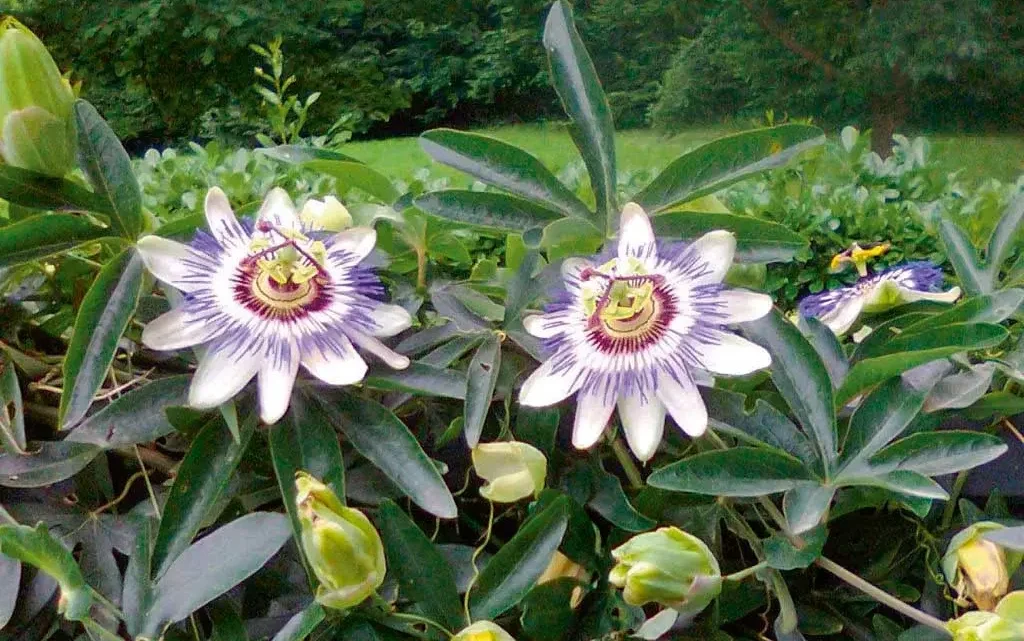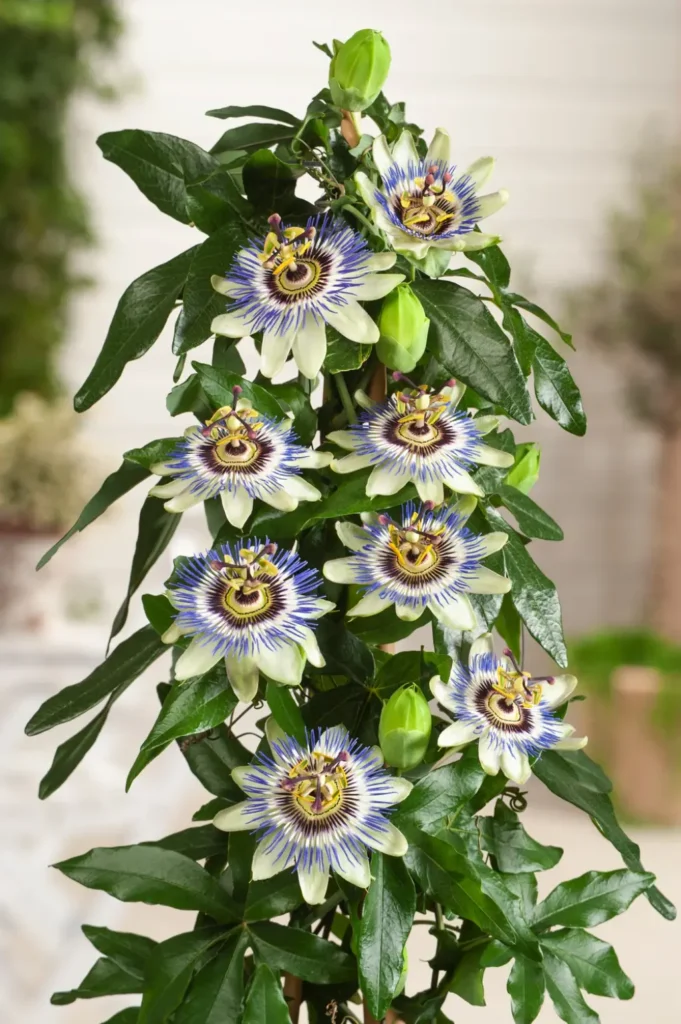
Passiflora caerulea, commonly known as the blue passion flower, is a stunning climber that captivates gardeners and plant enthusiasts with its intricate and exotic flowers. Native to South America, this vigorous plant is not only admired for its ornamental beauty but also for its ease of cultivation. In this comprehensive guide, we will explore everything you need to know about growing and caring for Passiflora caerulea, from planting to solving common problems.
Introduction to Beauty Passiflora Caerulea

Overview
Passiflora caerulea, also known as blue passion flower or hardy passion flower, belongs to the Passifloraceae family. This vigorous climber is known for its large, star-shaped flowers, which feature a unique combination of white and blue petals with a central crown of purple filaments. The flowers are followed by orange-yellow, egg-shaped fruits that are edible but not particularly flavorful.
History and Symbolism
The passion flower has a rich history and deep symbolism. Its name derives from the Latin «passio» (passion) and «flos» (flower), referring to the Passion of Christ. The flower’s complex structure was used by early Christian missionaries in South America as a symbolic representation of the Crucifixion. Each part of the flower was said to represent an element of the Passion of Jesus.
Why Grow Passiflora Caerulea?
Passiflora caerulea is a versatile and rewarding plant to grow. It can be trained over trellises, fences, and walls, providing a stunning visual display. Its rapid growth and vigorous nature make it an excellent choice for covering unsightly structures. Additionally, the plant attracts pollinators such as bees and butterflies, contributing to a healthy garden ecosystem.
Selecting the Right Location
Climate and Hardiness
Passiflora caerulea is hardy in USDA zones 6-10. It prefers a warm, sheltered location and can tolerate light frosts. In colder climates, it may require winter protection or be grown as a container plant that can be brought indoors during the colder months.
Sunlight Requirements
The blue passion flower thrives in full sun to partial shade. For optimal flowering, provide at least 6 hours of direct sunlight per day. In hotter climates, some afternoon shade can help protect the plant from intense heat.
Soil Conditions
Passiflora caerulea prefers well-drained soil rich in organic matter. It can tolerate a range of soil types, including sandy and loamy soils, but performs best in a slightly acidic to neutral pH (6.0-7.0).
Planting Passiflora Caerulea
When to Plant
The best time to plant Passiflora caerulea is in the spring after the last frost has passed. This gives the plant the entire growing season to establish itself before winter.
Planting Steps
- Prepare the Soil: Enrich the soil with compost or well-rotted manure to improve fertility and drainage.
- Dig a Hole: Dig a hole twice the width of the root ball and slightly deeper.
- Planting: Place the plant in the hole, ensuring the top of the root ball is level with the soil surface.
- Backfill: Fill in the hole with soil, pressing gently to remove air pockets.
- Watering: Water thoroughly after planting to help the plant settle in.
Seasonal Care Guide
Here’s a handy seasonal guide to help you manage your Passiflora caerulea care throughout the year:
| Jan | Feb | Mar | Apr | May | Jun | Jul | Aug | Sep | Oct | Nov | Dec | |
|---|---|---|---|---|---|---|---|---|---|---|---|---|
| Planting | yes | yes | ||||||||||
| Flowers | yes | yes | yes | yes | ||||||||
| Pruning | yes | yes |
Seasonal Care and Maintenance
Spring
In spring, focus on planting new Passiflora caerulea and performing light pruning to remove any dead or damaged growth. Apply a balanced fertilizer to encourage vigorous growth and abundant flowering.
Summer
During the summer, ensure the plant receives regular water, especially during dry spells. Mulch around the base to retain moisture and suppress weeds. Continue to support the plant as it grows, training it to climb trellises or other structures.
Fall
In the fall, after the flowering period has ended, perform a more thorough pruning to shape the plant and remove any overgrown or tangled stems. This helps prepare the plant for winter and encourages healthier growth in the spring.
Winter
In colder regions, protect the plant from frost by covering it with a horticultural fleece or moving container-grown plants indoors. Reduce watering during the winter months, as the plant will be in a dormant state.
Common Problems and Solutions
Pests
Passiflora caerulea is relatively resistant to pests, but it can occasionally be affected by:
- Aphids: Small, sap-sucking insects that can cause distorted growth. Control with insecticidal soap or neem oil.
- Spider Mites: Tiny mites that create webbing on the undersides of leaves. Increase humidity and use miticides if necessary.
- Whiteflies: Small, white-winged insects that can weaken the plant. Use sticky traps and insecticidal sprays.
Diseases
Common diseases include:
- Powdery Mildew: A fungal disease that appears as white, powdery spots on leaves. Improve air circulation and apply fungicides.
- Root Rot: Caused by waterlogged soil. Ensure proper drainage and avoid overwatering.
Environmental Stress
- Frost Damage: Protect the plant from late frosts with coverings or by relocating container plants indoors.
- Heat Stress: Provide afternoon shade in hot climates and ensure adequate watering.
Propagating Passiflora Caerulea
From Seeds
Passiflora caerulea can be propagated from seeds, although it requires patience as germination can be slow.
- Harvest Seeds: Collect seeds from ripe fruits and clean off any pulp.
- Sow Seeds: Sow seeds in a seed-starting mix and cover lightly with soil.
- Germination: Keep the soil moist and provide a warm environment. Germination can take several weeks to months.
From Cuttings
Propagation from cuttings is a quicker method.
- Take Cuttings: In spring or early summer, take 4-6 inch cuttings from healthy, non-flowering shoots.
- Prepare Cuttings: Remove the lower leaves and dip the cut end in rooting hormone.
- Plant Cuttings: Insert the cuttings into a pot filled with a well-draining mix. Keep the soil moist and provide indirect light.
- Rooting: Roots should develop in a few weeks, after which the cuttings can be transplanted.
Uses and Benefits
Ornamental Uses
Passiflora caerulea is primarily grown for its ornamental value. It can be used to:
- Cover Structures: Ideal for trellises, pergolas, and fences.
- Create Privacy: Acts as a natural screen for privacy.
- Attract Pollinators: Its flowers attract bees, butterflies, and hummingbirds.
Medicinal Uses
While the fruits are not particularly flavorful, some parts of the plant are used in traditional medicine for their sedative and anxiolytic properties. Always consult with a healthcare provider before using any plant for medicinal purposes.
Edible Uses
The fruits of Passiflora caerulea are edible but not widely consumed due to their bland taste. They can be used in jams or as a novelty fruit.
Conclusion
Passiflora caerulea, the blue passion flower, is a captivating addition to any garden. Its exotic flowers, vigorous growth, and ease of care make it a popular choice for gardeners. By selecting the right location, planting at the appropriate time, and providing seasonal care, you can enjoy the stunning beauty of this remarkable plant.
Whether you grow it for its ornamental value, its ability to attract pollinators, or its potential medicinal uses, Passiflora caerulea is sure to be a rewarding and enchanting presence in your garden.
Growing Passiflora caerulea requires attention to its specific needs, including proper planting techniques, seasonal care, and problem-solving. With the guidance provided in this comprehensive guide, you can cultivate a healthy and thriving blue passion flower that will bring beauty and joy to your outdoor space for years to come. Happy gardening!



